Jian Cao
Real-Time Decision-Making for Digital Twin in Additive Manufacturing with Model Predictive Control using Time-Series Deep Neural Networks
Jan 10, 2025Abstract:Digital Twin-a virtual replica of a physical system enabling real-time monitoring, model updating, prediction, and decision-making-combined with recent advances in machine learning (ML), offers new opportunities for proactive control strategies in autonomous manufacturing. However, achieving real-time decision-making with Digital Twins requires efficient optimization driven by accurate predictions of highly nonlinear manufacturing systems. This paper presents a simultaneous multi-step Model Predictive Control (MPC) framework for real-time decision-making, using a multi-variate deep neural network (DNN), named Time-Series Dense Encoder (TiDE), as the surrogate model. Different from the models in conventional MPC which only provide one-step ahead prediction, TiDE is capable of predicting future states within the prediction horizon in one shot (multi-step), significantly accelerating MPC. Using Directed Energy Deposition additive manufacturing as a case study, we demonstrate the effectiveness of the proposed MPC in achieving melt pool temperature tracking to ensure part quality, while reducing porosity defects by regulating laser power to maintain melt pool depth constraints. In this work, we first show that TiDE is capable of accurately predicting melt pool temperature and depth. Second, we demonstrate that the proposed MPC achieves precise temperature tracking while satisfying melt pool depth constraints within a targeted dilution range (10%-30%), reducing potential porosity defects. Compared to the PID controller, MPC results in smoother and less fluctuating laser power profiles with competitive or superior melt pool temperature control performance. This demonstrates MPC's proactive control capabilities, leveraging time-series prediction and real-time optimization, positioning it as a powerful tool for future Digital Twin applications and real-time process optimization in manufacturing.
LogLLM: Log-based Anomaly Detection Using Large Language Models
Nov 13, 2024



Abstract:Software systems often record important runtime information in logs to help with troubleshooting. Log-based anomaly detection has become a key research area that aims to identify system issues through log data, ultimately enhancing the reliability of software systems. Traditional deep learning methods often struggle to capture the semantic information embedded in log data, which is typically organized in natural language. In this paper, we propose LogLLM, a log-based anomaly detection framework that leverages large language models (LLMs). LogLLM employs BERT for extracting semantic vectors from log messages, while utilizing Llama, a transformer decoder-based model, for classifying log sequences. Additionally, we introduce a projector to align the vector representation spaces of BERT and Llama, ensuring a cohesive understanding of log semantics. Unlike conventional methods that require log parsers to extract templates, LogLLM preprocesses log messages with regular expressions, streamlining the entire process. Our framework is trained through a novel three-stage procedure designed to enhance performance and adaptability. Experimental results across four public datasets demonstrate that LogLLM outperforms state-of-the-art methods. Even when handling unstable logs, it effectively captures the semantic meaning of log messages and detects anomalies accurately.
Large Language Models for Constructing and Optimizing Machine Learning Workflows: A Survey
Nov 11, 2024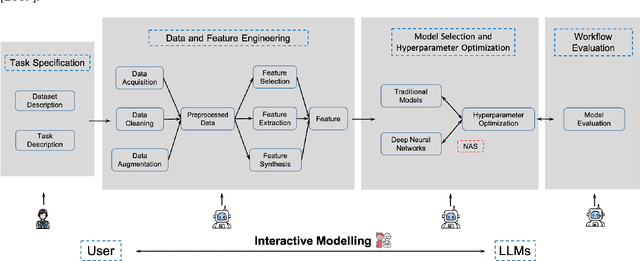
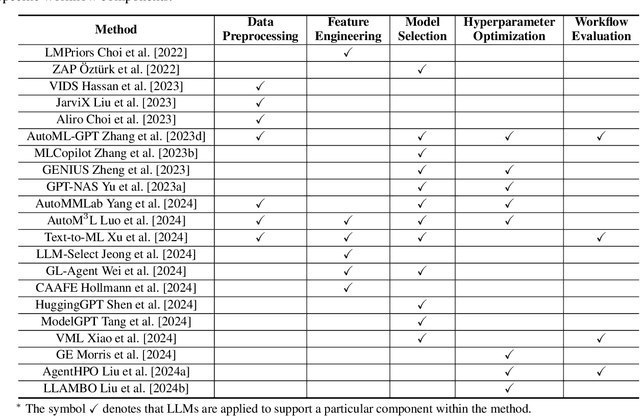

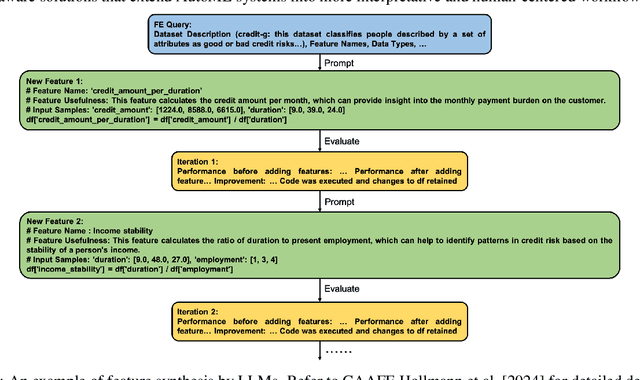
Abstract:Building effective machine learning (ML) workflows to address complex tasks is a primary focus of the Automatic ML (AutoML) community and a critical step toward achieving artificial general intelligence (AGI). Recently, the integration of Large Language Models (LLMs) into ML workflows has shown great potential for automating and enhancing various stages of the ML pipeline. This survey provides a comprehensive and up-to-date review of recent advancements in using LLMs to construct and optimize ML workflows, focusing on key components encompassing data and feature engineering, model selection and hyperparameter optimization, and workflow evaluation. We discuss both the advantages and limitations of LLM-driven approaches, emphasizing their capacity to streamline and enhance ML workflow modeling process through language understanding, reasoning, interaction, and generation. Finally, we highlight open challenges and propose future research directions to advance the effective application of LLMs in ML workflows.
FedL2G: Learning to Guide Local Training in Heterogeneous Federated Learning
Oct 09, 2024



Abstract:Data and model heterogeneity are two core issues in Heterogeneous Federated Learning (HtFL). In scenarios with heterogeneous model architectures, aggregating model parameters becomes infeasible, leading to the use of prototypes (i.e., class representative feature vectors) for aggregation and guidance. However, they still experience a mismatch between the extra guiding objective and the client's original local objective when aligned with global prototypes. Thus, we propose a Federated Learning-to-Guide (FedL2G) method that adaptively learns to guide local training in a federated manner and ensures the extra guidance is beneficial to clients' original tasks. With theoretical guarantees, FedL2G efficiently implements the learning-to-guide process using only first-order derivatives w.r.t. model parameters and achieves a non-convex convergence rate of O(1/T). We conduct extensive experiments on two data heterogeneity and six model heterogeneity settings using 14 heterogeneous model architectures (e.g., CNNs and ViTs) to demonstrate FedL2G's superior performance compared to six counterparts.
OutfitAnyone: Ultra-high Quality Virtual Try-On for Any Clothing and Any Person
Jul 23, 2024
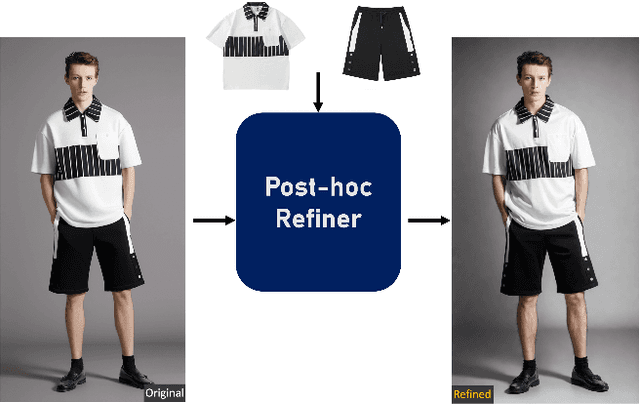


Abstract:Virtual Try-On (VTON) has become a transformative technology, empowering users to experiment with fashion without ever having to physically try on clothing. However, existing methods often struggle with generating high-fidelity and detail-consistent results. While diffusion models, such as Stable Diffusion series, have shown their capability in creating high-quality and photorealistic images, they encounter formidable challenges in conditional generation scenarios like VTON. Specifically, these models struggle to maintain a balance between control and consistency when generating images for virtual clothing trials. OutfitAnyone addresses these limitations by leveraging a two-stream conditional diffusion model, enabling it to adeptly handle garment deformation for more lifelike results. It distinguishes itself with scalability-modulating factors such as pose, body shape and broad applicability, extending from anime to in-the-wild images. OutfitAnyone's performance in diverse scenarios underscores its utility and readiness for real-world deployment. For more details and animated results, please see \url{https://humanaigc.github.io/outfit-anyone/}.
DABL: Detecting Semantic Anomalies in Business Processes Using Large Language Models
Jun 22, 2024Abstract:Detecting anomalies in business processes is crucial for ensuring operational success. While many existing methods rely on statistical frequency to detect anomalies, it's important to note that infrequent behavior doesn't necessarily imply undesirability. To address this challenge, detecting anomalies from a semantic viewpoint proves to be a more effective approach. However, current semantic anomaly detection methods treat a trace (i.e., process instance) as multiple event pairs, disrupting long-distance dependencies. In this paper, we introduce DABL, a novel approach for detecting semantic anomalies in business processes using large language models (LLMs). We collect 143,137 real-world process models from various domains. By generating normal traces through the playout of these process models and simulating both ordering and exclusion anomalies, we fine-tune Llama 2 using the resulting log. Through extensive experiments, we demonstrate that DABL surpasses existing state-of-the-art semantic anomaly detection methods in terms of both generalization ability and learning of given processes. Users can directly apply DABL to detect semantic anomalies in their own datasets without the need for additional training. Furthermore, DABL offers the capability to interpret the causes of anomalies in natural language, providing valuable insights into the detected anomalies.
Engineering software 2.0 by interpolating neural networks: unifying training, solving, and calibration
Apr 16, 2024Abstract:The evolution of artificial intelligence (AI) and neural network theories has revolutionized the way software is programmed, shifting from a hard-coded series of codes to a vast neural network. However, this transition in engineering software has faced challenges such as data scarcity, multi-modality of data, low model accuracy, and slow inference. Here, we propose a new network based on interpolation theories and tensor decomposition, the interpolating neural network (INN). Instead of interpolating training data, a common notion in computer science, INN interpolates interpolation points in the physical space whose coordinates and values are trainable. It can also extrapolate if the interpolation points reside outside of the range of training data and the interpolation functions have a larger support domain. INN features orders of magnitude fewer trainable parameters, faster training, a smaller memory footprint, and higher model accuracy compared to feed-forward neural networks (FFNN) or physics-informed neural networks (PINN). INN is poised to usher in Engineering Software 2.0, a unified neural network that spans various domains of space, time, parameters, and initial/boundary conditions. This has previously been computationally prohibitive due to the exponentially growing number of trainable parameters, easily exceeding the parameter size of ChatGPT, which is over 1 trillion. INN addresses this challenge by leveraging tensor decomposition and tensor product, with adaptable network architecture.
An Upload-Efficient Scheme for Transferring Knowledge From a Server-Side Pre-trained Generator to Clients in Heterogeneous Federated Learning
Mar 23, 2024Abstract:Heterogeneous Federated Learning (HtFL) enables collaborative learning on multiple clients with different model architectures while preserving privacy. Despite recent research progress, knowledge sharing in HtFL is still difficult due to data and model heterogeneity. To tackle this issue, we leverage the knowledge stored in pre-trained generators and propose a new upload-efficient knowledge transfer scheme called Federated Knowledge-Transfer Loop (FedKTL). Our FedKTL can produce client-task-related prototypical image-vector pairs via the generator's inference on the server. With these pairs, each client can transfer pre-existing knowledge from the generator to its local model through an additional supervised local task. We conduct extensive experiments on four datasets under two types of data heterogeneity with 14 kinds of models including CNNs and ViTs. Results show that our upload-efficient FedKTL surpasses seven state-of-the-art methods by up to 7.31% in accuracy. Moreover, our knowledge transfer scheme is applicable in scenarios with only one edge client. Code: https://github.com/TsingZ0/FedKTL
Towards a Digital Twin Framework in Additive Manufacturing: Machine Learning and Bayesian Optimization for Time Series Process Optimization
Feb 27, 2024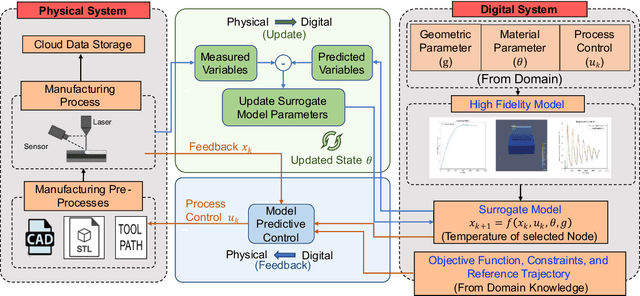
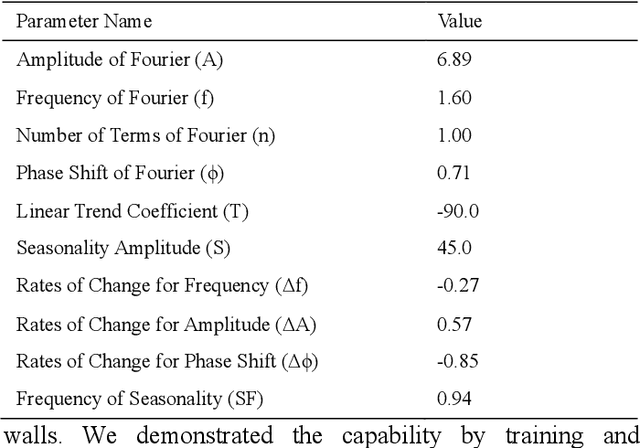
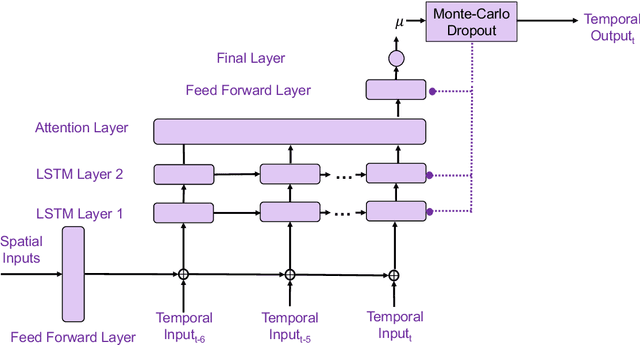
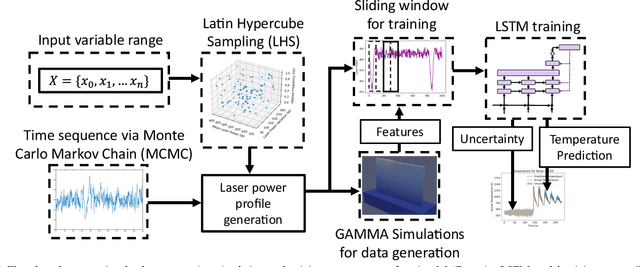
Abstract:Laser-directed-energy deposition (DED) offers advantages in additive manufacturing (AM) for creating intricate geometries and material grading. Yet, challenges like material inconsistency and part variability remain, mainly due to its layer-wise fabrication. A key issue is heat accumulation during DED, which affects the material microstructure and properties. While closed-loop control methods for heat management are common in DED research, few integrate real-time monitoring, physics-based modeling, and control in a unified framework. Our work presents a digital twin (DT) framework for real-time predictive control of DED process parameters to meet specific design objectives. We develop a surrogate model using Long Short-Term Memory (LSTM)-based machine learning with Bayesian Inference to predict temperatures in DED parts. This model predicts future temperature states in real time. We also introduce Bayesian Optimization (BO) for Time Series Process Optimization (BOTSPO), based on traditional BO but featuring a unique time series process profile generator with reduced dimensions. BOTSPO dynamically optimizes processes, identifying optimal laser power profiles to attain desired mechanical properties. The established process trajectory guides online optimizations, aiming to enhance performance. This paper outlines the digital twin framework's components, promoting its integration into a comprehensive system for AM.
FedTGP: Trainable Global Prototypes with Adaptive-Margin-Enhanced Contrastive Learning for Data and Model Heterogeneity in Federated Learning
Jan 06, 2024

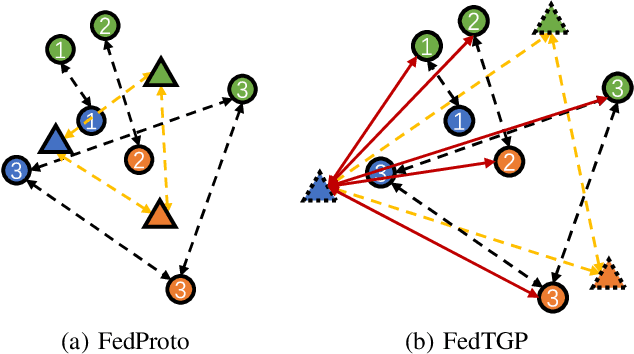

Abstract:Recently, Heterogeneous Federated Learning (HtFL) has attracted attention due to its ability to support heterogeneous models and data. To reduce the high communication cost of transmitting model parameters, a major challenge in HtFL, prototype-based HtFL methods are proposed to solely share class representatives, a.k.a, prototypes, among heterogeneous clients while maintaining the privacy of clients' models. However, these prototypes are naively aggregated into global prototypes on the server using weighted averaging, resulting in suboptimal global knowledge which negatively impacts the performance of clients. To overcome this challenge, we introduce a novel HtFL approach called FedTGP, which leverages our Adaptive-margin-enhanced Contrastive Learning (ACL) to learn Trainable Global Prototypes (TGP) on the server. By incorporating ACL, our approach enhances prototype separability while preserving semantic meaning. Extensive experiments with twelve heterogeneous models demonstrate that our FedTGP surpasses state-of-the-art methods by up to 9.08% in accuracy while maintaining the communication and privacy advantages of prototype-based HtFL. Our code is available at https://github.com/TsingZ0/FedTGP.
 Add to Chrome
Add to Chrome Add to Firefox
Add to Firefox Add to Edge
Add to Edge